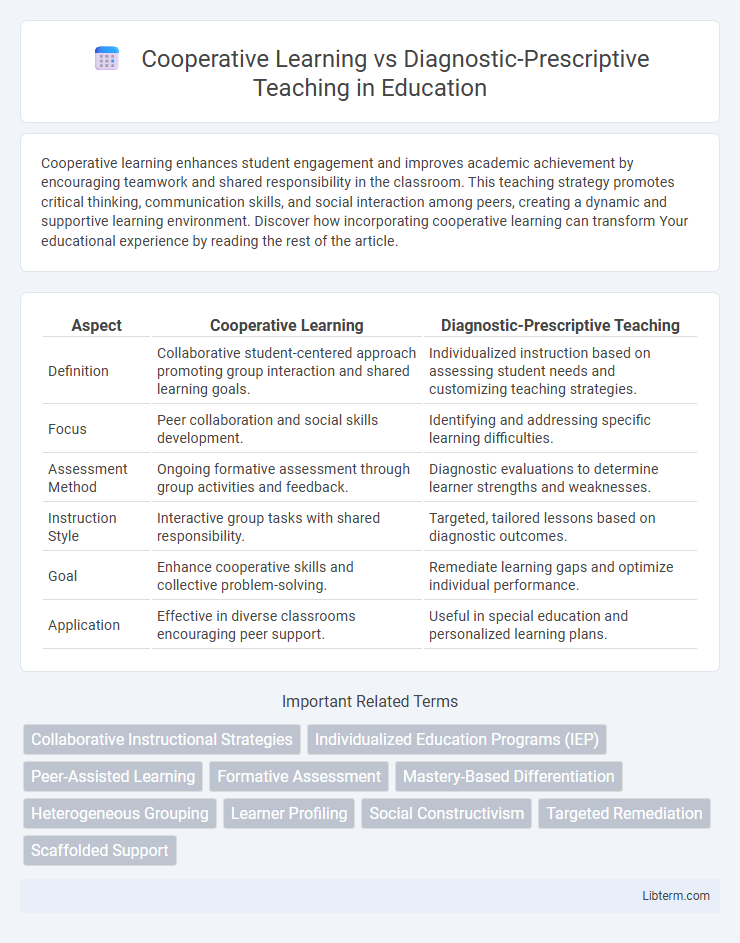Cooperative learning enhances student engagement and improves academic achievement by encouraging teamwork and shared responsibility in the classroom. This teaching strategy promotes critical thinking, communication skills, and social interaction among peers, creating a dynamic and supportive learning environment. Discover how incorporating cooperative learning can transform Your educational experience by reading the rest of the article.
Table of Comparison
| Aspect | Cooperative Learning | Diagnostic-Prescriptive Teaching |
|---|---|---|
| Definition | Collaborative student-centered approach promoting group interaction and shared learning goals. | Individualized instruction based on assessing student needs and customizing teaching strategies. |
| Focus | Peer collaboration and social skills development. | Identifying and addressing specific learning difficulties. |
| Assessment Method | Ongoing formative assessment through group activities and feedback. | Diagnostic evaluations to determine learner strengths and weaknesses. |
| Instruction Style | Interactive group tasks with shared responsibility. | Targeted, tailored lessons based on diagnostic outcomes. |
| Goal | Enhance cooperative skills and collective problem-solving. | Remediate learning gaps and optimize individual performance. |
| Application | Effective in diverse classrooms encouraging peer support. | Useful in special education and personalized learning plans. |
Introduction to Cooperative Learning and Diagnostic-Prescriptive Teaching
Cooperative learning emphasizes student collaboration through structured group activities that enhance communication, social skills, and collective problem-solving. Diagnostic-prescriptive teaching involves assessing individual learner difficulties to tailor instruction based on diagnosed needs, improving targeted skill development. Both approaches aim to optimize educational outcomes by addressing diverse student requirements through interactive and personalized methods.
Defining Cooperative Learning
Cooperative learning is an instructional approach where students work collaboratively in small groups to achieve shared academic goals, enhancing social interaction and individual accountability. This strategy promotes active participation, critical thinking, and communication skills by encouraging learners to engage with diverse perspectives and support each other's understanding. Unlike diagnostic-prescriptive teaching, which focuses on individualized assessment and tailored interventions, cooperative learning emphasizes peer collaboration and collective problem-solving.
Understanding Diagnostic-Prescriptive Teaching
Diagnostic-Prescriptive Teaching involves identifying students' learning difficulties through assessments and tailoring instructional strategies to address specific gaps in knowledge or skills. This approach emphasizes personalized learning paths, enabling teachers to target weaknesses and enhance individual student progress efficiently. By continuously monitoring and adjusting teaching methods, Diagnostic-Prescriptive Teaching promotes mastery of concepts and supports differentiated instruction.
Core Principles and Approaches
Cooperative Learning emphasizes collaboration, peer interaction, and shared responsibility among students to enhance understanding and problem-solving skills, promoting social and cognitive development. Diagnostic-Prescriptive Teaching centers on identifying individual student learning gaps through assessment and providing tailored instructional strategies to address specific weaknesses. Both approaches aim to improve educational outcomes but differ by fostering group dynamics in Cooperative Learning versus personalized remediation in Diagnostic-Prescriptive Teaching.
Key Differences Between the Methods
Cooperative learning emphasizes student collaboration and active peer interaction to enhance understanding and social skills, while diagnostic-prescriptive teaching centers on assessing individual learning needs and tailoring instruction accordingly. In cooperative learning, knowledge construction occurs through group problem-solving and shared responsibility, contrasting with the diagnostic-prescriptive approach's focus on identifying specific deficits and delivering targeted interventions. The key differences lie in cooperative learning's collective engagement versus diagnostic-prescriptive teaching's individualized assessment and customized instruction.
Benefits of Cooperative Learning
Cooperative learning fosters improved academic achievement by encouraging active peer interaction and collaborative problem-solving, which enhances critical thinking skills. It promotes social development and communication competencies, facilitating a supportive classroom environment that boosts student motivation and engagement. Research shows cooperative learning also increases retention rates and helps diverse learners by allowing personalized peer support within group activities.
Advantages of Diagnostic-Prescriptive Teaching
Diagnostic-Prescriptive Teaching offers tailored instruction by identifying individual learner's strengths and weaknesses through continuous assessment, enabling targeted interventions that enhance learning outcomes. This approach facilitates personalized feedback and customized lesson plans, resulting in improved student comprehension and skill mastery. Emphasizing precise diagnosis of learning difficulties promotes efficient use of instructional time and resources, maximizing educational effectiveness.
Challenges and Limitations
Cooperative Learning challenges include group dynamics issues such as unequal participation, social loafing, and conflicts that can hinder individual accountability and learning outcomes. Diagnostic-Prescriptive Teaching faces limitations in accurately identifying learners' specific needs due to time constraints and the complexity of measuring diverse learning styles and cognitive processes. Both methods require significant teacher expertise and resources to implement effectively, often limiting their scalability in diverse classroom settings.
Best Practices for Classroom Implementation
Cooperative learning fosters active student engagement through group activities that promote peer interaction and collaborative problem-solving, enhancing social and academic skills. Diagnostic-prescriptive teaching relies on continuous assessment to identify individual learning gaps, allowing customized instructional strategies tailored to each student's needs. Best practices include integrating cooperative learning structures with regular diagnostic assessments to balance group dynamics and personalized support, ensuring effective differentiation and improved learning outcomes.
Choosing the Right Approach for Diverse Learners
Cooperative Learning fosters collaboration and peer interaction, promoting social skills and collective problem-solving, which benefits diverse learners through shared knowledge and support. Diagnostic-Prescriptive Teaching offers personalized instruction by identifying individual student strengths and weaknesses, enabling targeted interventions that address specific learning gaps. Selecting the right approach depends on the learners' needs, with Cooperative Learning enhancing engagement and communication, while Diagnostic-Prescriptive Teaching ensures tailored academic progress for varied student profiles.
Cooperative Learning Infographic

 libterm.com
libterm.com